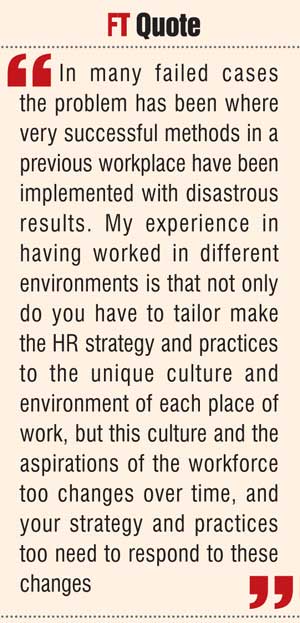Tuesday Mar 04, 2025
Tuesday Mar 04, 2025
Friday, 15 May 2015 00:00 - - {{hitsCtrl.values.hits}}

Modern HR is proactive and focuses significantly on HR development as well
I thought of writing this article because I have come across many cases where young HR professionals, and even CEOs, have made fundamental mistakes in HR although they were well versed with the theoretical aspects, and very familiar with modern HR concepts.
Some of them have sought my advice which I have willingly given. My advice was based on lessons I learned, and sometimes the hard way, dealing with complex HR issues in the several places where I worked.
Not a one size fits all concept
In many failed cases the problem has been where very successful methods in a previous workplace have been implemented with disastrous results. My experience in having worked in different environments is that not only do you have to tailor-make the HR strategy and practices to the unique culture and environment  of each place of work, but this culture and the aspirations of the workforce too changes over time, and your strategy and practices too need to respond to these changes.
of each place of work, but this culture and the aspirations of the workforce too changes over time, and your strategy and practices too need to respond to these changes.
When I first became involved with Dankotuwa Porcelain in the early 1990s the workforce was young, mostly unmarried and their social life was the factory. Quality Circles, 5S and Kaizen worked very well. Their enthusiasm to participate in these programmes was very high. As time went by, these workers got married and their needs and wants changed. Many years later their children were studying for OL and AL exams and their whole focus was on the education of their children, the factory was only a place to earn their living and nothing more. They were no longer interested in Quality Circles, their social network was no longer the factory.
The trade union leaders too underwent a change. They were very supportive of these initiatives initially, and were genuinely focused on the development of the organisations but later changed their focus. Now all they wanted was to become known and popular and finally contest the Pradeshiya Sabha elections.
It becomes a challenge to the HR function to adjust to these changes, and formulate new strategies on a regular basis, while at the same time motivating and retaining the new XGen and YGen workers who join as new recruits. Keeping the newer workers motivated was a separate huge challenge.
When I first learnt about the subject of HR it was called Personnel Management and in my first few places of work there existed a Personnel Department not a HR Department. The old concept of Personnel Management was more administrative and more reactive while modern HR is more proactive and focuses significantly on HR development as well.
The power of motivation
Years ago I came across an article where the Industrial Bank of Japan (IBJ) had found that many of their non-performing facilities were a result of poor HR practices of their clients. The business idea was sound, they had a very good product, the company was well capitalised but still they had failed. In fact IBJ had formulated an interesting equation which said P = MH x S x Mn.
This essentially meant that Performanc e (P) is a not only a function of man hours (MH) and skill (S) but also the level (n) of motivation (M). M to the power of n shows that when n is zero, since M0 =1, P = just MH x S. If n can be increased to a higher number P is enhanced by a huge multiple.
e (P) is a not only a function of man hours (MH) and skill (S) but also the level (n) of motivation (M). M to the power of n shows that when n is zero, since M0 =1, P = just MH x S. If n can be increased to a higher number P is enhanced by a huge multiple.
When I took over as MD of Merchant Bank I found a similar story; many projects we had funded had gone bad, and we had to write off many such investments and loans. Bad HR had been a significant issue. We organised several seminars for our clients so that they would better manage their affairs. Although done in our own self-interest, our clients benefited immensely. I have always maintained that if we need to develop entrepreneurs in this country we need to not merely provide them with capital but also guide them in better management, particularly the SMEs. This became the philosophy if IBJ too.
Learning from trade unions
Some of my early exposures to academics cum practitioners included Professor John Carson who taught us, the MBA group of 1983 to 1986, Personnel Management at the Sri Jayewardenepura University. He had started his career as a Personal Officer, had later headed the Canadian Civil Service and became an academic rising to the position of Professor of Personnel Management.
Although we studied his brand new book on Personnel Management during that semester, we thoroughly enjoyed his many anecdotes of incidents in practicing personnel management. One lesson, which I have used many a time, was on collective bargaining with trade unions.
As a young personnel officer he was once given in charge of the bargaining process. First it was with the electrical workers union and after a full day’s negotiations the new hourly rate was agreed upon. The next day it was the mechanical workers union, and although every year negotiations went on for a full day, the final agreed rate was the same as for the electrical workers.
Young Carson thought he will be smart, and at the start of the negotiations on day two with the mechanical union he said: “Gentlemen we all know that every year we finally agree to the same rate as the electrical workers so let’s not waste time, I am announcing that the management is agreeable to this rate so let’s shake hands and seal the deal.”
The union was furious, walked out in protest, demanded fresh negotiations, and after many days agreed to a rate a few dollar cents above that of the electric workers. Young Carson just couldn’t fathom what went wrong.
At the customary cocktail party after the collective agreement was finally signed, a senior unionist from the headquarters approached Carson and had told him where he went wrong. “What do you think our membership would have thought if we reached agreement within half an hour?” Clarifying further he said: “Our members expect us to negotiate hard, to push and pummel the management for a full day, and extract with great difficulty the best deal from a tough management team.” Young Carson learnt a lesson of his life. I used to follow this very often, sometimes going late into the night negotiating.
Handling terminations
My first lessons in handling labour were in my first job at State Engineering Corporation over 40 years ago. Since the Termination of Employment of Workmen Act didn’t apply to Corporations it was fairly easy to terminate an employee, but you would obviously engage the wrath of the Minister who had provided employment to the worker who you terminated.
When you terminate a worker after three written warnings, he would go straight to the Minister and show him the letter. Immediately the Minister would call up the Officer in Charge of the site and berate him for terminating “his man” on such a trivial matter.
A senior colleague taught me how to handle this. When you notice a bad egg you give him many verbal warnings, then issue a written warning citing all the verbal warnings too, and finally your letter of termination, maybe months later, runs into several pages citing all the verbal and written warnings.
The worker as usual goes running to the Minister with the letter and the Minister reads the termination letter and this time berates the worker: “After I found a job for you is this how you behave, see the number of warnings you have received. Don’t ever come back to me again for another job.” That was the end of the matter. The above example may not fit in with modern HR management practices but it was a practical situation.
Worker is not just a pair of hands
In the same organisation there was a senior engineer far ahead of his time where HR was concerned, he was a well-known communist too. His lectures to us still reverberate in my ears. All of us would call workers by their check roll number. He advised us never to do this. “People like to be called by their proper name” he said.
He taught us to inquire about their children because that is their greatest treasure he said. Help them whenever you can because they are very poor people and will look up to you as their patron. Being young and unmarried at the time this was not easy for me to understand, but I found the results of such treatment amazing. They responded very well. This was still the era of paternalistic management. It was still the era where the worker was treated as a human being with a heart and not just a pair of hands.
Worker with a brain waiting to be tapped
While some elements of the old styles of management are still valid, I have realised unbelievable results by treating workers as a resource with a brain to be tapped. The success of Quality Circles and Kaizen programmes amply bear testimony to this. The modern worker is far more educated and seeking far more involvement and engagement than about three decades ago. They wish to see more democracy at the workplace. At the same time their financial demands are also higher because of the consumerist environment all around them.
Today’s workers believe that they are as good as or better than their supervisors. They believe they can make many improvements in the way work is done, and believe that they can contribute much more if they are given an opportunity. They want their brains to be used, and not just their hands. They are no longer happy being a mere beneficiary of a paternalistic manager.
But there is still a place for caring management. A Japanese management expert when advising an export oriented company was told by his local counterpart that it is easy to practice many good productivity techniques in Japan because the Japanese worker was so hard working and loyal unlike his Sri Lankan counterpart. The Japanese expert shot back that the Japanese workers’ loyalty is in response to how he is treated by his management.
Explaining this further he said in a Japanese company if a worker is absent for three days without notice, his boss will visit his house to find what is wrong. He said sometimes he may be very sick or a family member may be very sick and the last of his priorities is to inform his workplace. He needs help desperately.
In a typical Sri Lankan company, he said, the boss would wait for the three days to be completed to immediately send the “vacation of post” notice. In some Japanese companies the HR department has a record of the birthdays of the employees’ children, and the employee is given a birthday present to be given to the child. That has built the loyalty of the whole family to the company.
I tried a similar exercise at Merchant Bank where I personally sent a birthday card to every employee on his birthday. One day I received a call from an office aide full of emotion that it was the very first birthday card he received in his life.
Financial appeasement alone can backfire
Financial appeasement alone can be very dangerous. When Dankotuwa Porcelain was making very good profits, it was tempting for the management to be generous. The expectation was that a workforce satisfied with good incomes would be highly motivated. The reverse happened.
Their lifestyle changed: with the purchase of vehicles, children in international schools, high social expenditure, new houses, etc. and they soon found that they needed more money. Since they were the highest paid in the ceramics industry at that time, their demands for a large salary increase in a particular year was not granted. They struck work and the matter was referred to arbitration.
The arbitrator’s verdict was revealing “the generosity of the management has backfired,” he said. “By giving so many benefits and salary increases, year on year, high expectations were created in the minds of workers and these are therefore legitimate expectations.”
Therefore the arbitrator recommended a further salary increase “to keep up with the expectations”. Basically what the arbitrator said was that you have given so much and you cannot stop or reduce now, you have to satisfy the high expectations of the worker, it is your fault for having created these expectations.
It was very disappointing that when I visited several garment factories at that same time their wages were half of what we were paying, we had given uniforms, shoes, subsidised lunch subsidised transport, many loan schemes, school books for children, etc. and therefore even the female workers worked till retirement but the level of motivation was not in the same proportion.
The secret was that the unions and politicians were telling them they could get more. During a previous phase of my career a team from our office stayed in an estate bungalow since we had embarked on a project close by. The owner of the estate was very proud of the facilities he had for workers; the best afternoon meal in the area, aprons and caps, TV in the leaf shed (when TV was first introduced with only ITN), incentives, bonuses, subsidised transport for those travelling from a distance, etc.
At the end of the explanation a very senior, and obviously a wiser, retired person in our group asked the tea maker whether people really appreciate all these benefits. After a long pause the answer was, “I really don’t know”. The retired officer cautioned that these initiatives may one day backfire.
When we visited the same estate many months later, we were surprised to see many vehicles belonging to various Government institutions, and we could hear a speech being made using a sound system. The speaker was saying: “It is true you get so many benefits, perhaps more than the other estates around, but that is because this estate makes huge profits and the owner can really give you much more. We will fight for you and get better benefits for you if you join our union.”
A Government-controlled union was formed that day, they made impossible demands, workers struck work, and the owner finally in great disgust withdrew many of the non-compulsory benefits including the TV.
I am certainly not saying unions are undesirable but un-initiated union leaders can wreak havoc. I have always preferred to work with unions. In fact my experience is that the head offices of the unions have very reasonable officers, and will moderate the unreasonable expectations of branch unions.
My practice of HR management has been fashioned with a mix of theory, modern concepts, coupled with advice from my experienced bosses, the Employers’ Federation of Ceylon, Trade Union leaders, and former Commissioners of Labour. I believe that young HR practitioners, and even young CEOs handling large labour forces, need guidance from many such sources so that could blend their theory with practical experiences.
(Sunil G. Wijesinha has held many positions as the CEO and Chairman in Government and private sector organisations. He has been a pioneer in promoting Japanese style management and Employee Involvement Concepts in Sri Lanka. He was awarded Honorary Life Membership by the Institute of Personnel Management of Sri Lanka, and a medal for Distinguished Service to Society by the Postgraduate Institute of Management Alumni Society. He can be reached via [email protected].)
Discover Kapruka, the leading online shopping platform in Sri Lanka, where you can conveniently send Gifts and Flowers to your loved ones for any event including Valentine ’s Day. Explore a wide range of popular Shopping Categories on Kapruka, including Toys, Groceries, Electronics, Birthday Cakes, Fruits, Chocolates, Flower Bouquets, Clothing, Watches, Lingerie, Gift Sets and Jewellery. Also if you’re interested in selling with Kapruka, Partner Central by Kapruka is the best solution to start with. Moreover, through Kapruka Global Shop, you can also enjoy the convenience of purchasing products from renowned platforms like Amazon and eBay and have them delivered to Sri Lanka.
Discover Kapruka, the leading online shopping platform in Sri Lanka, where you can conveniently send Gifts and Flowers to your loved ones for any event including Valentine ’s Day. Explore a wide range of popular Shopping Categories on Kapruka, including Toys, Groceries, Electronics, Birthday Cakes, Fruits, Chocolates, Flower Bouquets, Clothing, Watches, Lingerie, Gift Sets and Jewellery. Also if you’re interested in selling with Kapruka, Partner Central by Kapruka is the best solution to start with. Moreover, through Kapruka Global Shop, you can also enjoy the convenience of purchasing products from renowned platforms like Amazon and eBay and have them delivered to Sri Lanka.